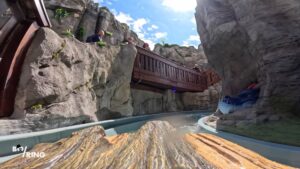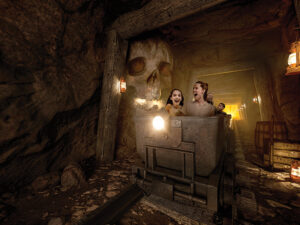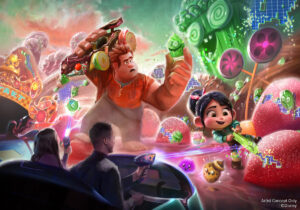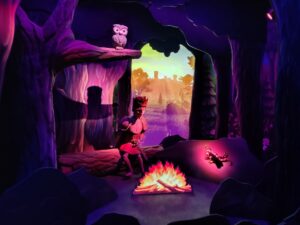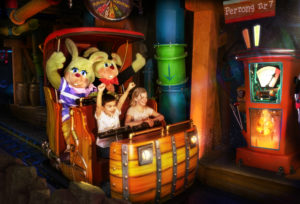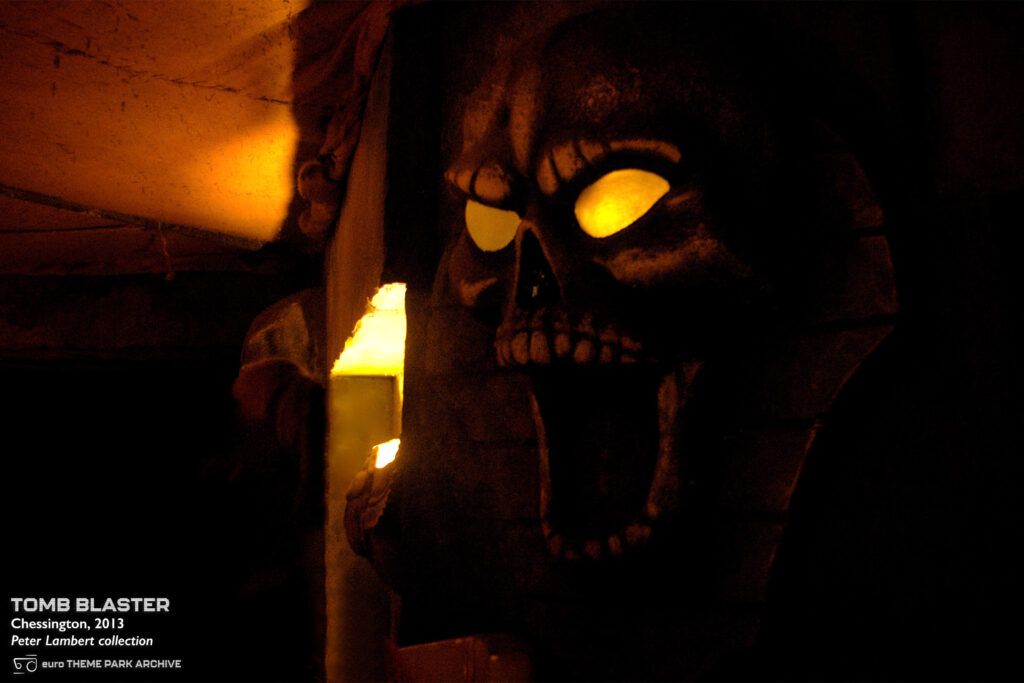
30 years ago this spring saw the opening of Terror Tomb at Chessington World of Adventures, a giant new dark ride for the UK. Opening with the Forbidden Kingdom area in 1994, guests explored an Egyptian tomb following jewel thief Abdab as he searches to steal treasure – with a twist!
In 2002, the ride relaunched as Tomb Blaster, an interactive shooting ride, which it continues to operate as today through many alterations. On its anniversary, we explore the ambitious making of this well-known attraction with previously unseen production material, newly uncovered from the studio archives.
The 5th Dimension Closure
It will come as a surprise to many that such a Chessington staple was once entirely different. The 5th Dimension was a huge, high-concept dark ride, truly unlike anything in the UK when it opened with the park in 1987. The ride took guests on a satirical adventure through a virtual reality simulation, hosted by computer troubleshooter robot Zapomatic. From its bespoke transit system, obscure premise, sophisticated animatronics and a double-storey building (so large it struggled to be filled), it was an ambitious attempt at an Epcot Future World-styled attraction.
Although a fantastic memory for those lucky to ride it, the ride had faltered on Tussauds’ early learning curve and wound up as a white elephant in the park’s lineup. Having already been revamped in its second season, the ride closed in 1993 to be redeveloped, in-line with the park concept of cultural themed lands. Its large interior would be entirely stripped down to the building and ride system, leaving a massive space to fill for Chessington’s newest adventure.
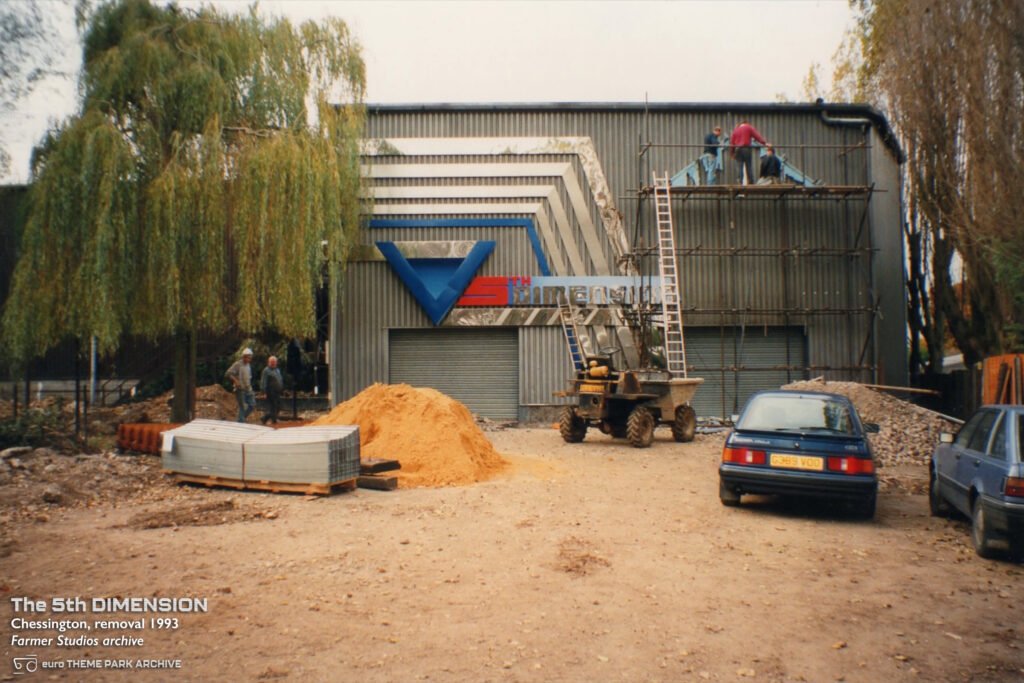
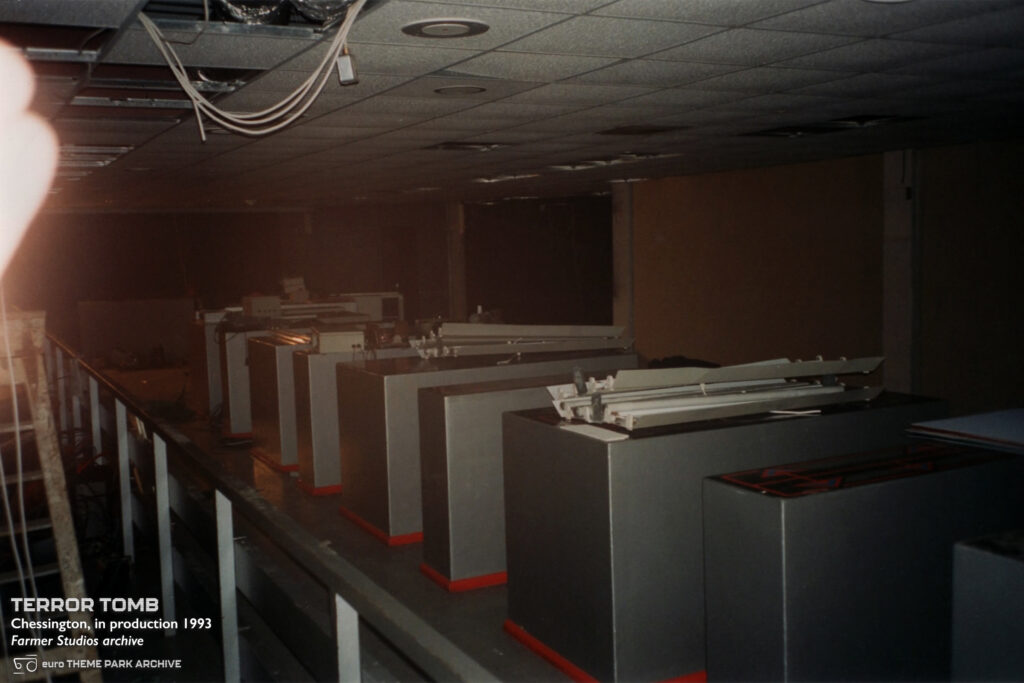
Left: the original entrance, which would become disused. Right: the station being stripped.
Designing Terror Tomb
Tackling this big new project would be a challenge. Until then, the Tussauds Group had been able to contract their new attractions to an experienced external UK studio or, in recent cases, their in-house Tussauds Studios. However, Tussauds Studios were fully occupied building multiple projects for 1994 (especially Nemesis and Toyland Tours at Alton Towers), while the studio behind their recent dark rides, Sparks Creative, had recently closed.
Tussauds needed to take a chance on a new studio to deliver this major project and, at the suggestion of John Wardley, nominated Farmer Studios in Leicester. Farmer were highly regarded for the quality of their animations and had already created features for Chessington, such as the angry dragon Frazzle, laughing pirate Peg Leg Pete and figures for the Bubble Works, but nothing of this scale before.
Before settling on Forbidden Kingdom as an Ancient Egyptian area, Chessington’s brief was to create a place where lost cultures collided, ‘The Land That Time Forgot’. The marketing brief determined the ride should have a spooky but humorous appeal; other than this, the concept was left open for interpretation. Uncharacteristically, the Tussauds Park Development team had much more of a passive role in the creative development of this ride than usual (likely due to John Wardley being fully occupied with Alton Towers), effectively giving Farmer Studios complete creative freedom under their design and build contract.
Kicking off in March 1993, with the working name ‘Tombstone Tours‘, the studio team had only one year to completely develop, design and build the entire attraction – shorter than most major UK dark ride projects. The team was encouraged to start with boundless disconnected ideas to encourage a more original theme, leading to some truly out-there brainstorming that produced some of the ride’s final elements such as an archaeological theme and a musical show.
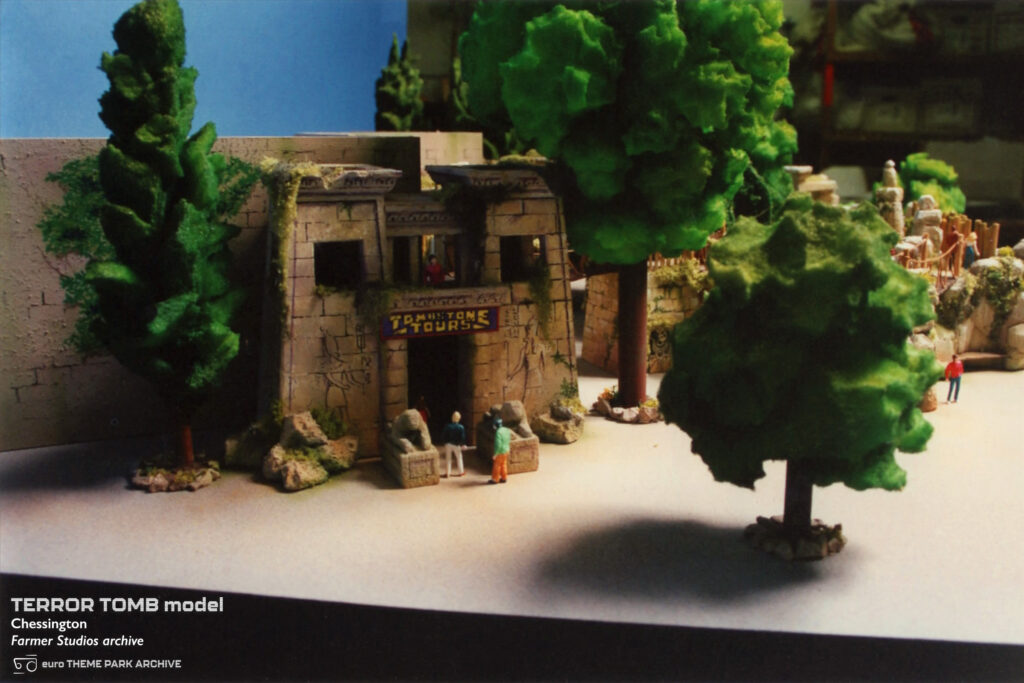

Left: the exterior, including its working title ‘Tombstone Tours’. Right: the Tomb Gates.
Within a few months, Farmer Studios returned with a plan for an epic-scale adventure through an ancient tomb. Led by the studio’s creative director Steven Pearce, the concept was developed into a complete scale design model. However, this wasn’t Terror Tomb as we would get to know it.
The existence of this earlier design was unknown until a surprise discovery in the Farmer archives and reveals an entirely different story, with alternative takes on many familiar scenes in Terror Tomb. Most notably the theme focused more on fantasy and comic humour than scares, following a noble explorer and his dog on a journey to find treasure.
With limited design time, a curveball came when Chessington requested the ride be scarier with more horror appeal. The model was torn up and quickly redesigned. This saw the introduction of Abdab, simplifying the original characters into a single lead – a villain after the tomb’s emerald treasure for himself!
Many scenes from the first concept were carried over and adapted to the new story, such as the giant lava pit and rock musical finale, where a tomb robber is sacrificed by a mummified guitarist (named the ‘Spooky Guitarist’ during production). Also notable was how the final design managed the budget for the large footprint by bringing forwards many of the sets, resulting in smaller scenes than on The 5th Dimension, and use of UV scenery to give the impression of more detail. The more comical humour was thrown out and some narrative scenes cut, replaced by ghost train-inspired elements such as the supersized trommel (vortex) tunnel and axe-throwing shadows gag.
Production

By September 1993, the new design, Terror Tomb, was finalised and put into production. The 5th Dimension had closed early in the season to give more time to strip the interiors, leaving some seriously large spaces. Its silver-blue trains were repainted in gold and blue and the ride system reprogrammed to match the new scenes.
Set pieces were built by the talented studio teams in Leicester, which had to take on roughly double the staff for the project. The project progressed through construction with all hands on deck, including a huge amount of scenic painting, numerous ghouls, snakes and animated figures, with of course every piece bespoke-made to Farmer’s high standards.
All the animations were built by the studio’s high quality engineering team, designed to be far simpler than The 5th Dimension’s advanced but maintenance-heavy animatronics. Farmer were also invited to tour the recently-opened Alton Towers Haunted House to view the similar challenges of delivering a major project under pressure.
All-round creative powerhouse Steven Pearce, having already storyboarded, designed and modelled most of the ride, even built many parts himself including sculpting Abdab’s face, painting backdrops and building the Spooky Guitarist in collaboration with Farmer’s engineering team. It’s probably fair to say no single person worked more on a dark ride project in the UK than Steve on Terror Tomb, who often went without full sleep on the last few weeks and doing several jobs at once to get the ride finished!
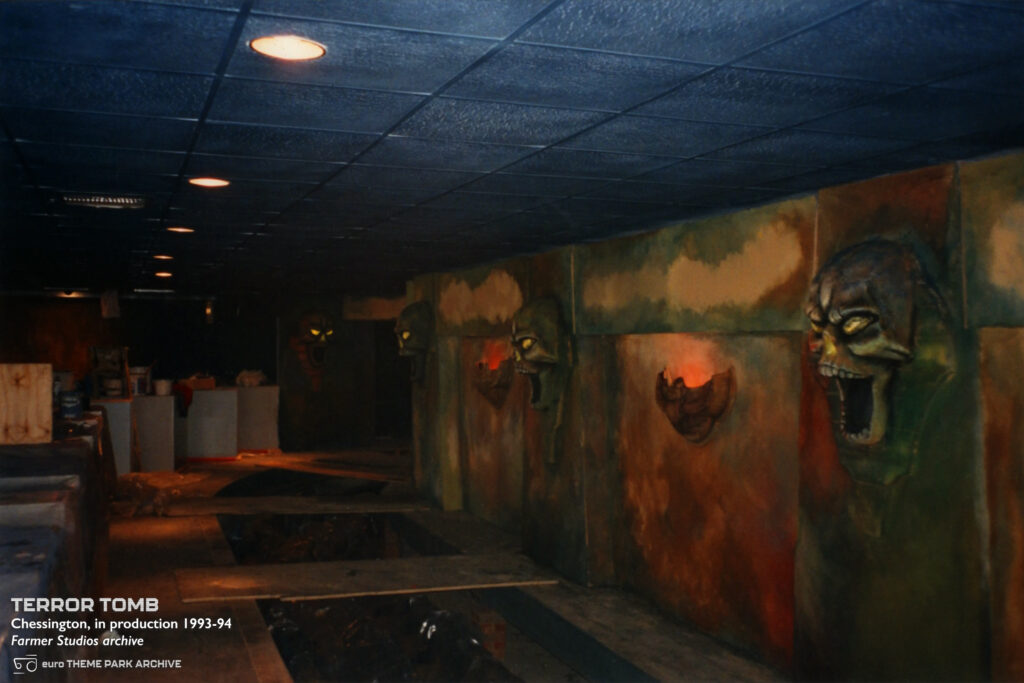

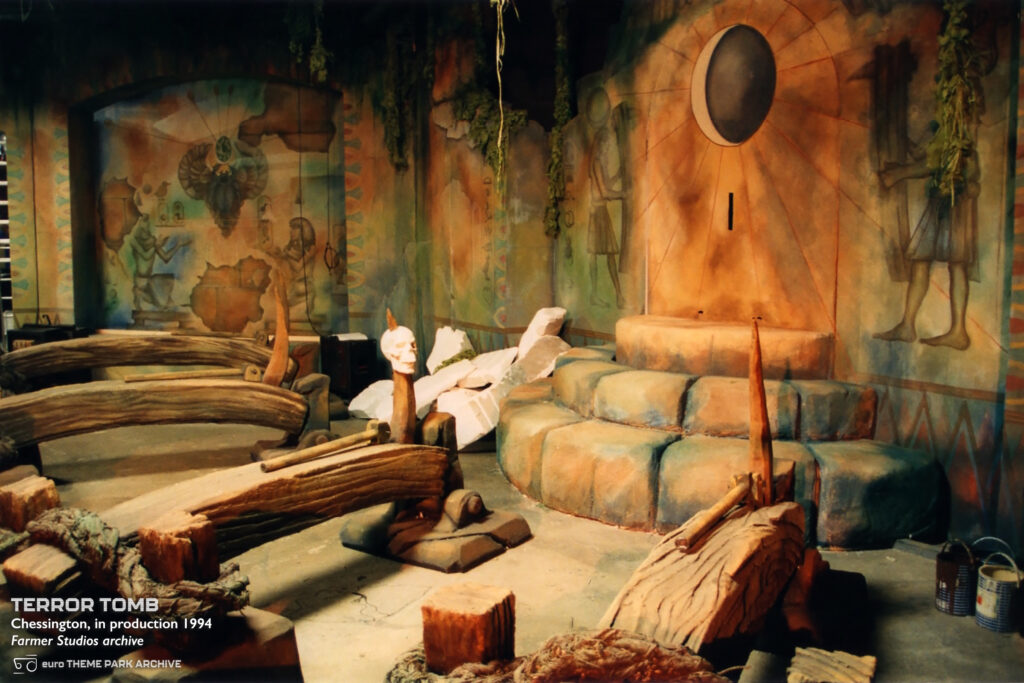

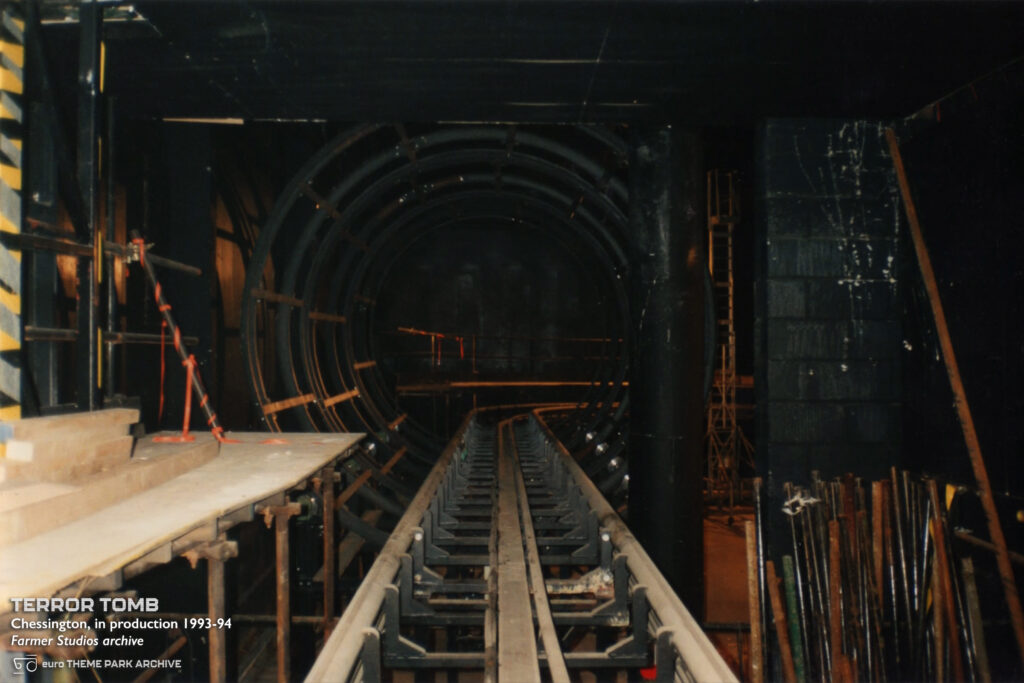
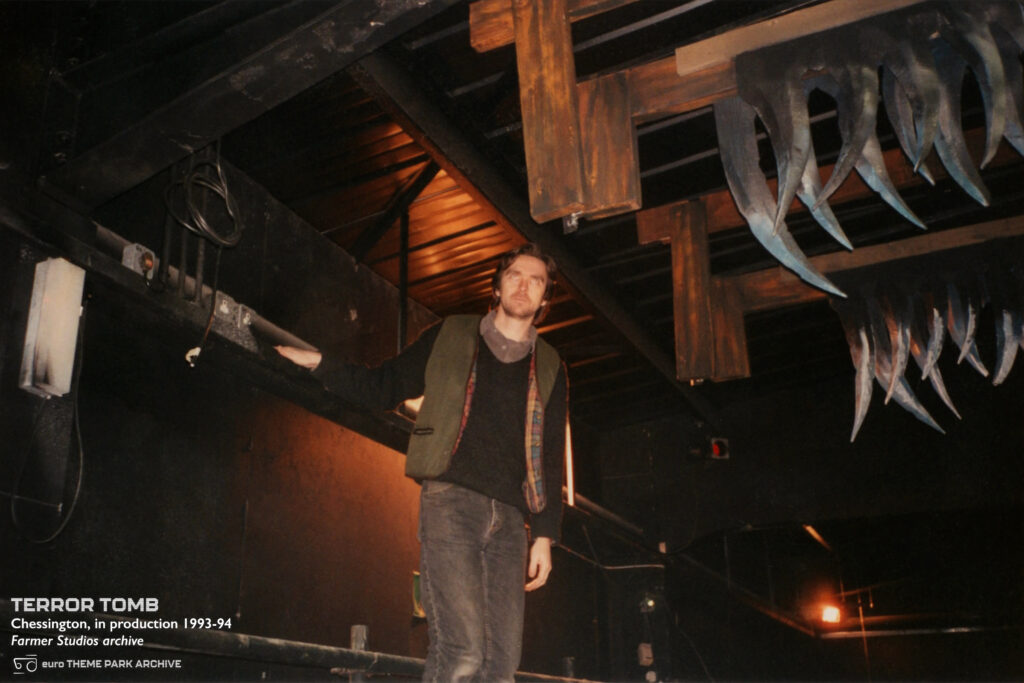
The ride’s fantastic musical score was produced by Tussauds’ regular composer Graham Smart, comprising music for each scene building to the surprise rock finale (named as ‘Jukebox Jewel’). The Jukebox Jewel lyrics were coined by Steven Pearce, who briefed Smart on how the track should sound. Smart brought in session musicians for the complex guitar solo and vocals, while he completed the rest of the orchestral and ambient pieces at his home studio.
The soundtrack was made complete with Abdab’s vocals; memorable for the sheer dedication the professional voice actor put into all that cartoon yelling and cackling. In one of the ride’s amusing traits, Abdab would audibly repeat his lines due to the long trains taking longer to pass each scene than had perhaps been anticipated at recording.
Ride Experience
From the grand entrance, Terror Tomb began with guests exploring the Forbidden Kingdom area over bridges and rooftops, before walking into a small bazaar where the tour guide, Abdab, can be seen asleep in his office clutching a map showing an emerald.
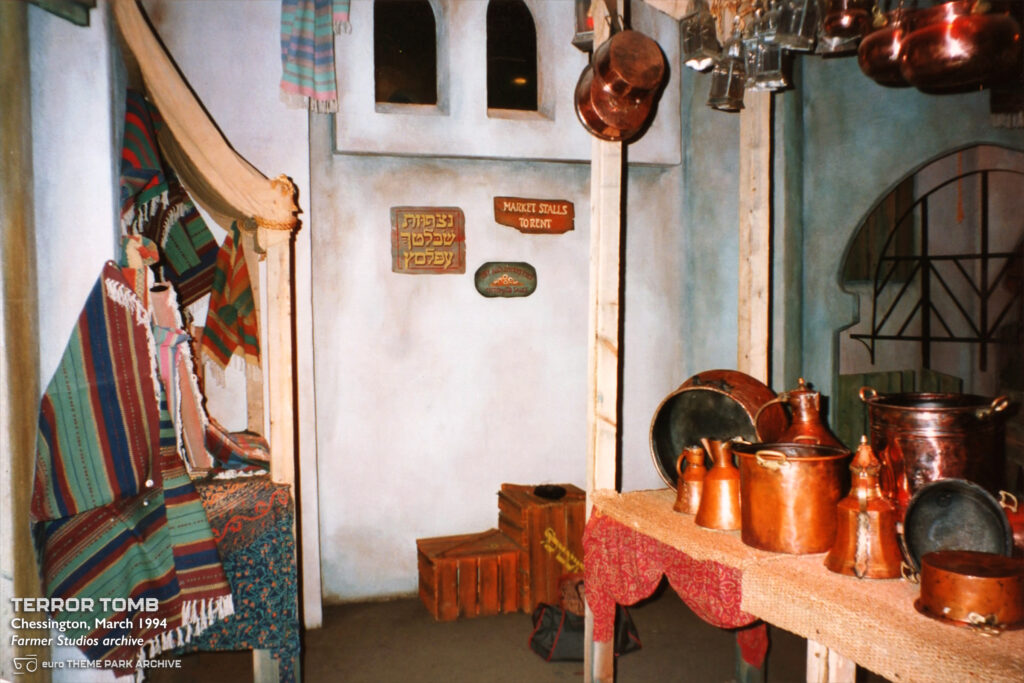
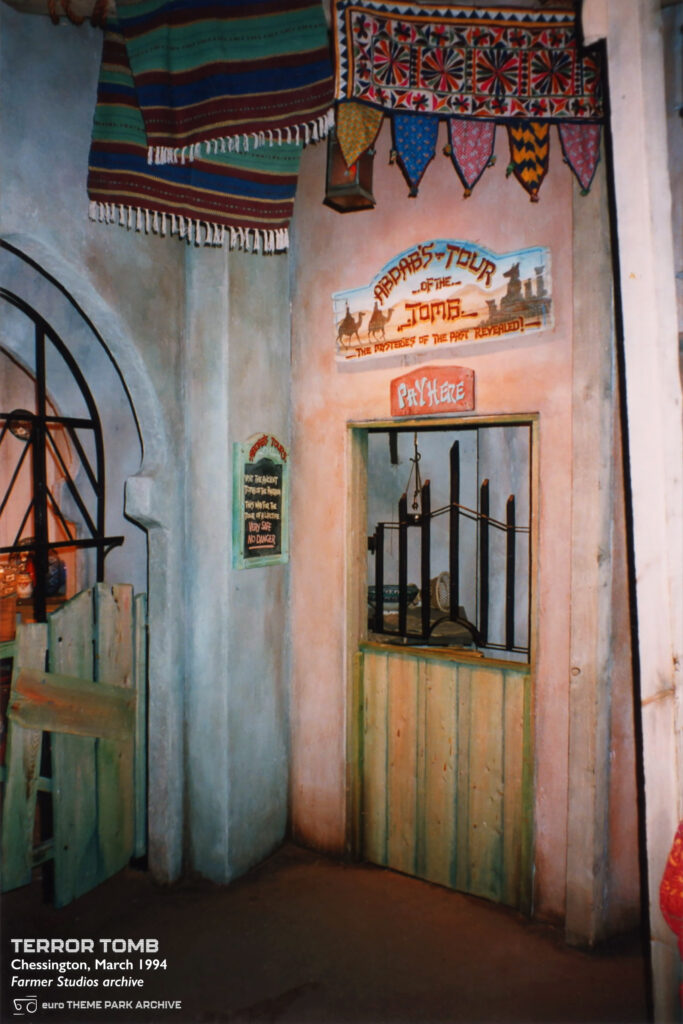
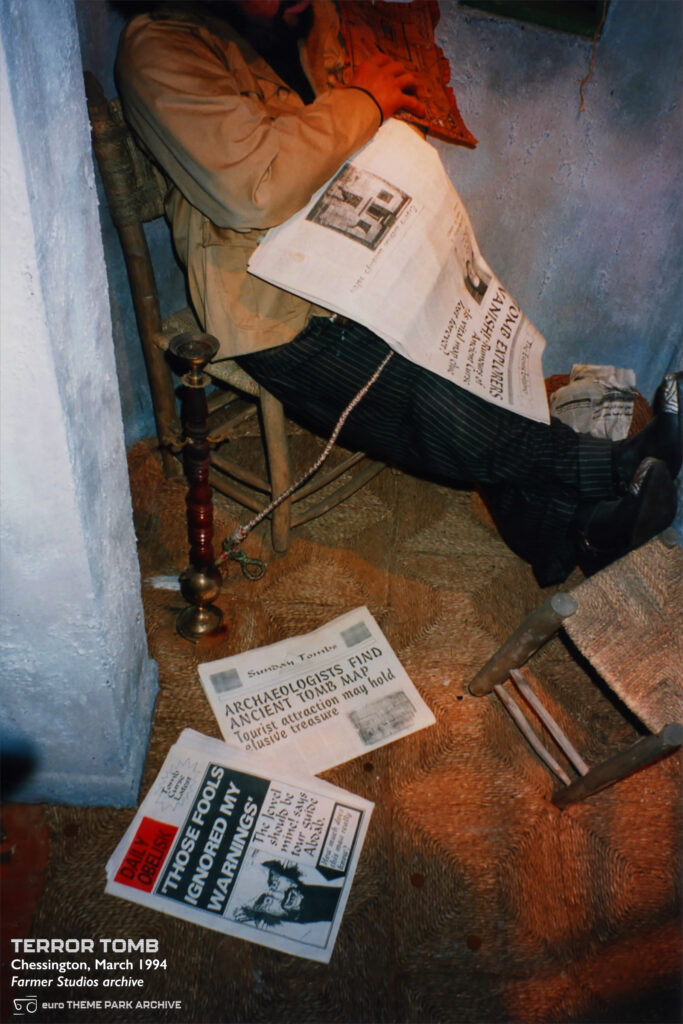
The indoor queue-line / pre-show area where guests could first spot Abdab asleep, holding the tomb map.
Passing this, guests wondered into the tomb through a dim, musty scented passage, originally stopping at a door that opened to reveal a sinister inner chamber (the station) with each batch. As each train departed, skull lanterns across the wall grew ominously brighter accompanied by a growing shriek, sending guests into the dark void ahead.
Now awake, Abdab would appear yelling at the steps of the tomb gates – ‘It’s closed. Shut. Get it? No more stupid tourists in this tomb!’ – and hinting at the tomb’s promised treasure. As the train climbed the ramp into the tomb, a large boulder, taking obvious inspiration from Indiana Jones, rolls along stone plinths overhead and crashes behind.
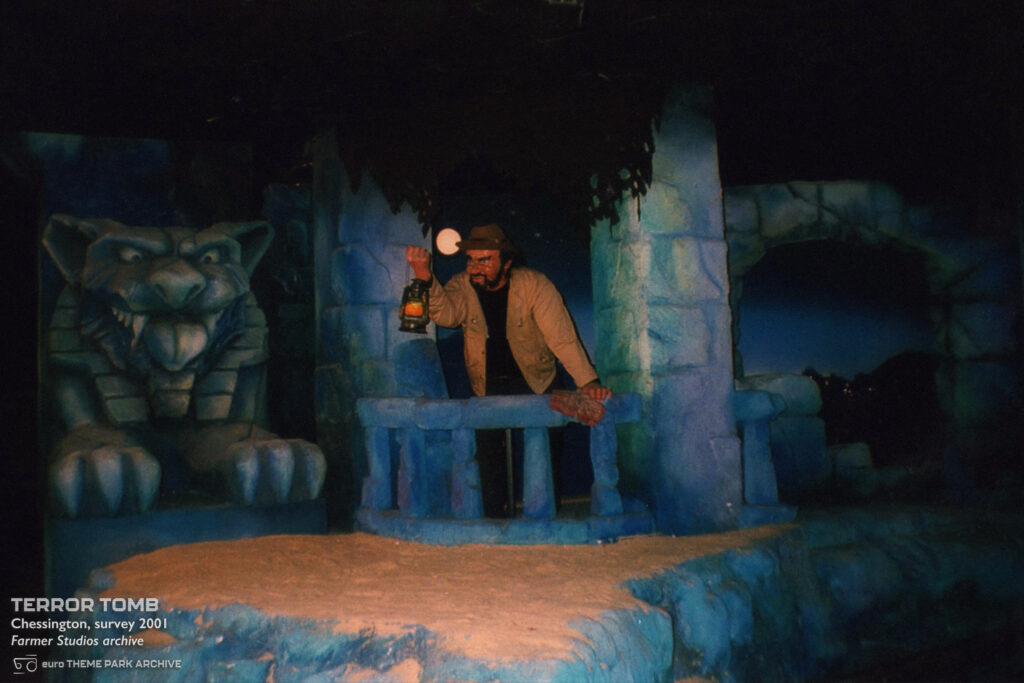

The Tomb Gates, ramp and rolling boulder. Left: flash photo. Right: pictured with the work lights on, the actual scene was very dark and lit with UV lighting.
At the top, guests entered a pit teaming with snakes, let in through a hatch by Abdab heaving on a rope and pulley. ‘If you think this is bad, just you wait! I’ll stop you, that emerald’s mine!’
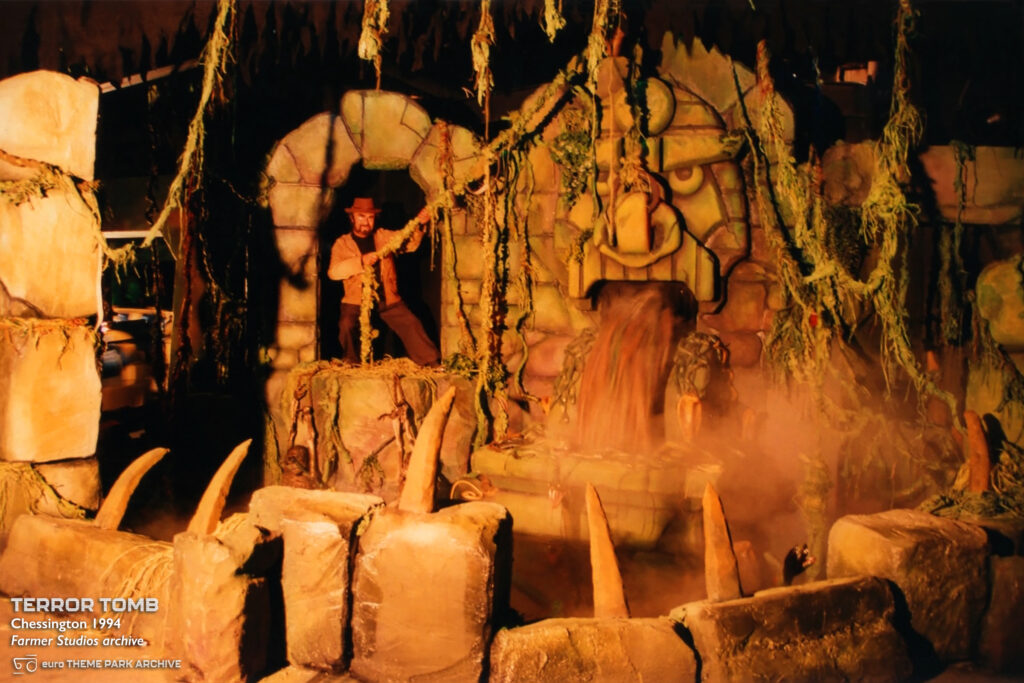
Through another snake filled passage, the trains stopped in darkness as wooden stakes mounted with spikes can be seen aimed in front. Abdab reappeared, grasping a large booby trap ring, which he pulls to release the spikes on us. Instead, the wall around him revolved, trapping him behind – ‘What’s this? A secret passage! I think I’m on to something!’ A wall to the left illuminated, letting us view the passage behind, as Abdab is seen leaning into a sarcophagus – ‘Here it is! I’ve found it!’ Leaning further, Abdab toppled into the casket, which is quickly shut by a cackling ghoul clutching the real treasured emerald.
From here the atmosphere turned to mischief as more mummified ghouls appear, one cranking a large saw-toothed contraption overhead (a scene termed the ‘Head Trimmer’), and others throwing axes that appear to land in the wall beside us.
As the music builds to a climax, the view opened up to a large pit of lava overlooked by a huge jackal statue, eyes beaming as smoke bellows from below. This dramatic scene took place in the largest part of the building, a triple storey section as the track spirals down to a lower level. To one side Abdab could be seen again, now clinging to a leaning obelisk as it crumbles, as he tries to reach the emerald held in a ring on the jackal’s paw.

Through the trommel tunnel the train entered an ominous, large chamber, turned to face the centre and stopped. The room was in darkness other than chanting stone faces, with Abdab now captured and tied to a sarcophagus in the centre. As the suspense builds, the room burst into life with a wild light show and the squealing of electric guitar. A regally-dressed mummy appeared high on a pedestal, soloing on an emerald-green, scarab styled guitar, and a trio of mummified dancers in stilettos grooved opposite. A lid of spikes laying in front of Abdab lit up as the undead band taunted Abdab in song.
‘You dare to steal the ancient jewel, so now YOU shall become a ghoul!’
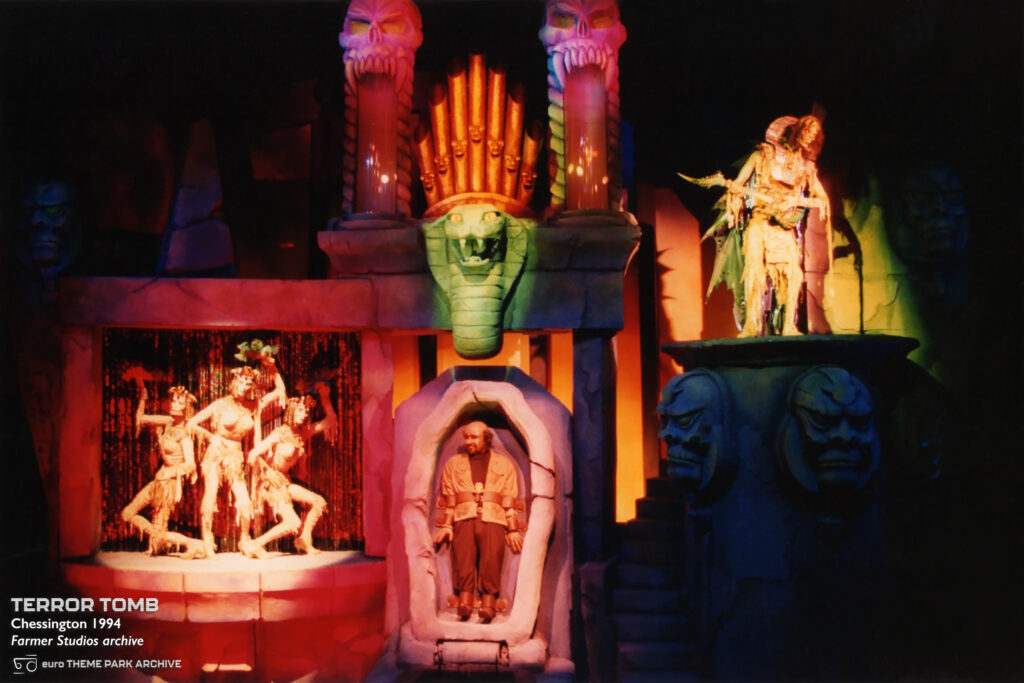
The rocking guitarist continued as the spiked lid began to rise in front of Abdab with a plume of smoke. He pleaded for our help before the sarcophagus shuts on him, with the emerald embedded just out of reach on the other side of the lid. His screams turned to cackles as the lights dimmed, leaving the sarcophagus in a ghoulish green glow, the music came to a dissonant end and the train left the chamber. Green light followed into the next passage, accompanied by Abdab’s echoing laughter.
Suddenly, corpses would fall towards us from the darkness with a loud shriek, the ride’s biggest fright, before disappearing into shadows again. The musical theme turned warped and surreal as Abdab reappeared ahead in a final twist, clutching the emerald at last, his eyes a ghoulish yellow and holes punctured over his body. ‘It’s mine at last! I said you’d never get it!’ he cackles, in a line delivered hilariously maniacal. The train stopped, the lights came up and guests exited to the offload platform with triumphant theme music playing.

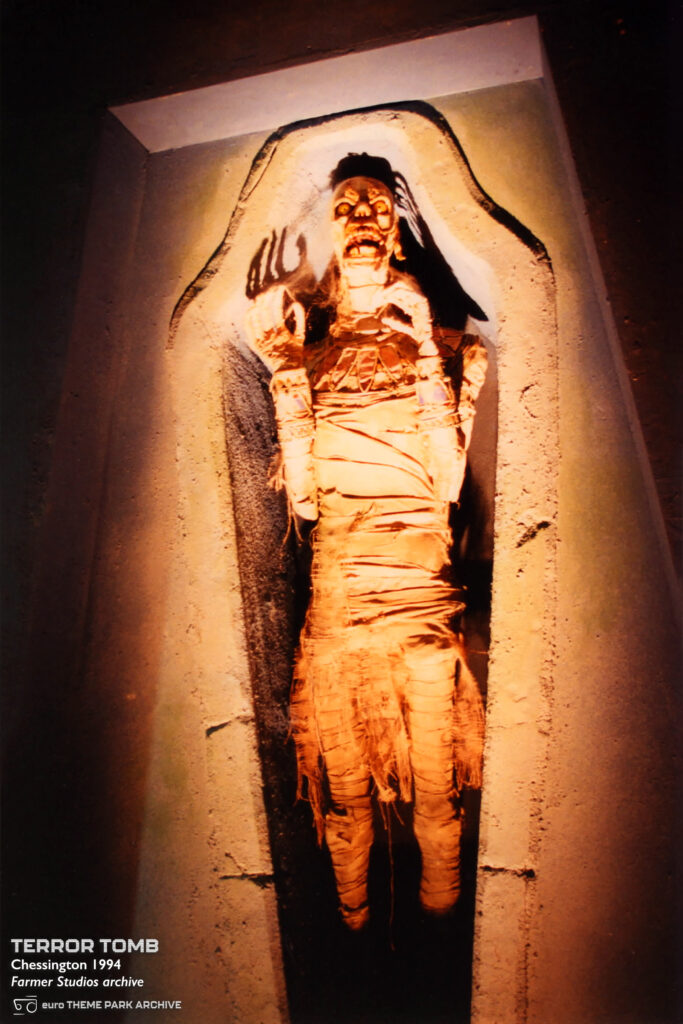
That March, Terror Tomb finished technical rehearsals ready to launch to the public for the 1994 season. The press event took place on March 25th, hosted by Ulrika Jonsson (host of the Gladiators TV show). It was launched with a surprise stunt spectacle, featuring a live actor as Abdab and a stunt performer on a zip-line arriving to save Jonsson, before the entrance to the ride was blown open with pyrotechnics. You can’t argue Terror Tomb didn’t open with a bang! The ride saw summer queues stretching back towards the log flume and it went on to be a very successful addition for the park.

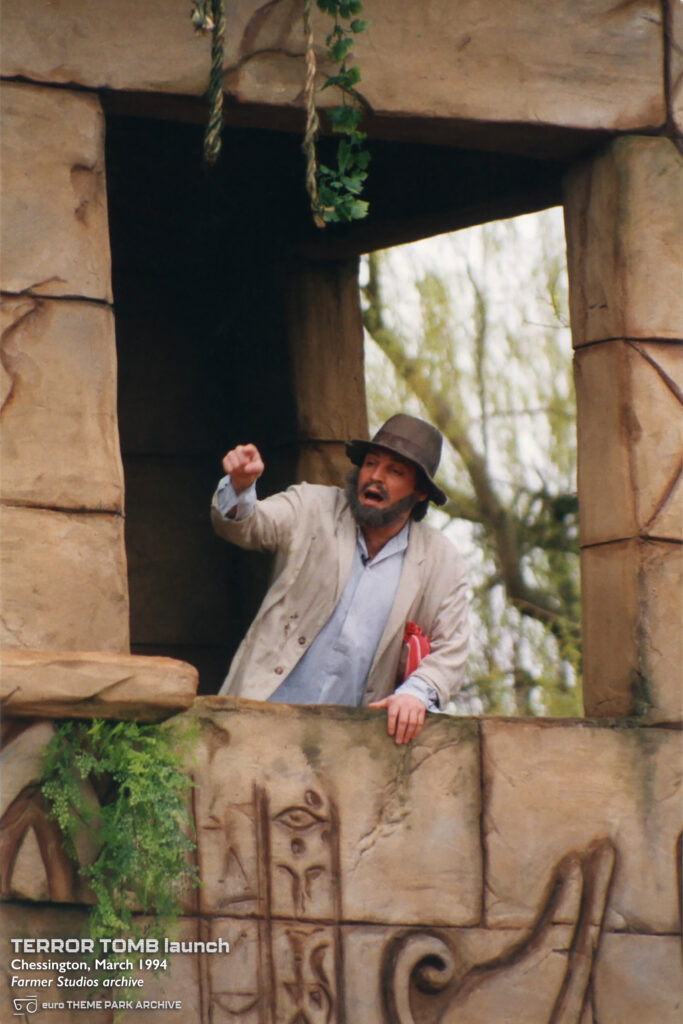
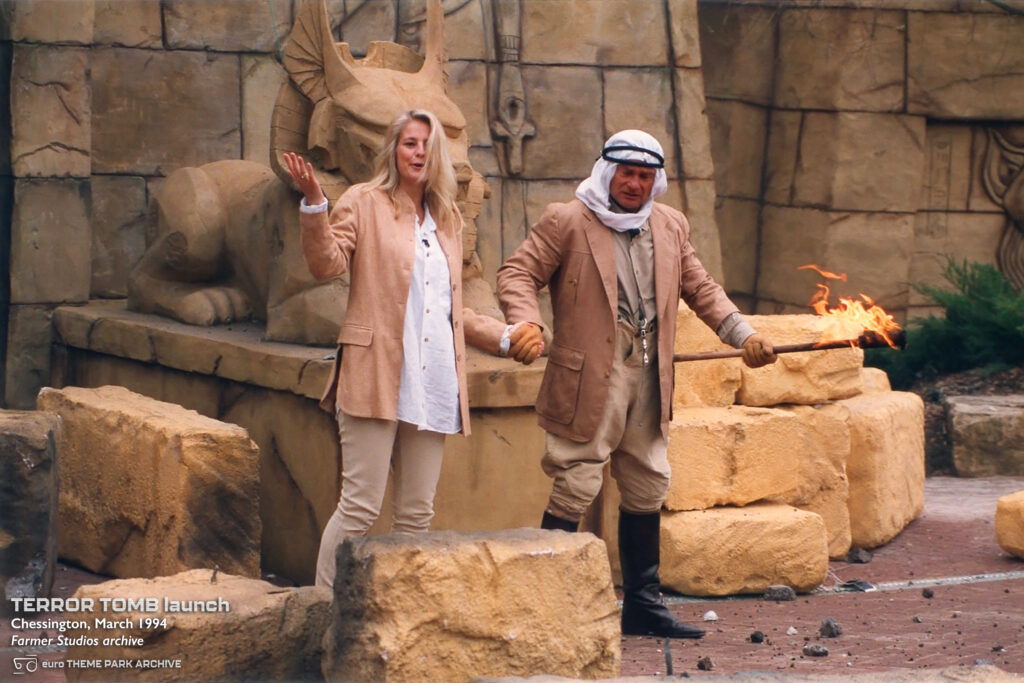
1996 Revamp
As is typical with many dark rides, the ride received some alterations in its first few seasons, as part of a mini revamp in 1996. This was contracted to T.H.E. Ltd, a studio that had started out of the ashes of Sparks Creative Services and shared some of the same team. Due to this, some of the changes had similarities with the Alton Towers Haunted House with the addition of UV strobe-lit flying heads, in a previously empty pocket at the very end of the ride.
The main change was to the ‘Head Trimmer’ scene, purportedly damaged by guests grabbing the overhead saws, which saw it replaced by an assortment of ghost train style props: a jump scare gag of a jackal shaking a cage and a skeleton dangling over a well.
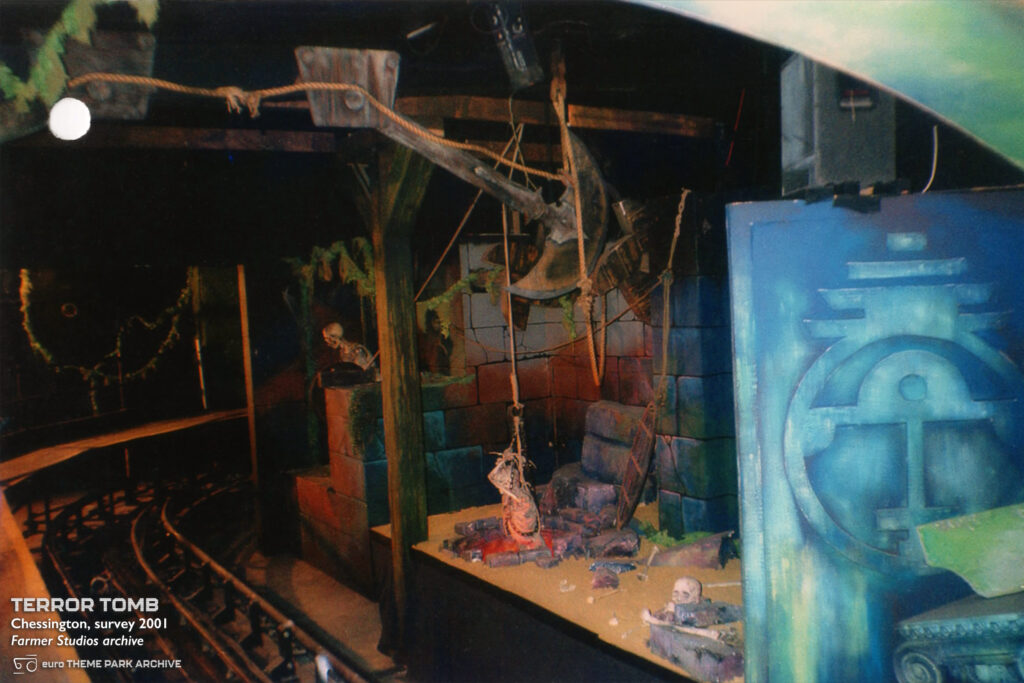
A more solid change included the addition of glowing red light in ghoul Abdab’s spiked body, as this memorable effect was absent from the figure originally. Other alterations included new blacklight scenic art on a previous blank wall in the opening scene, and an extra lighting cue of a lightning strike when Abdab activates the Spike room trap door. The changes ranged from faithful to random, as commented on by some of the T.H.E. team themselves, but mainly didn’t tamper with the ride’s tone.
The ride received another change in 1999 / 2000 with a renaming to Forbidden Tomb, however no changes to the ride took place. This was part of a spate of attraction rebrandings by a new marketing team at Chessington, which saw several rides change names at that time.
Tomb Blaster
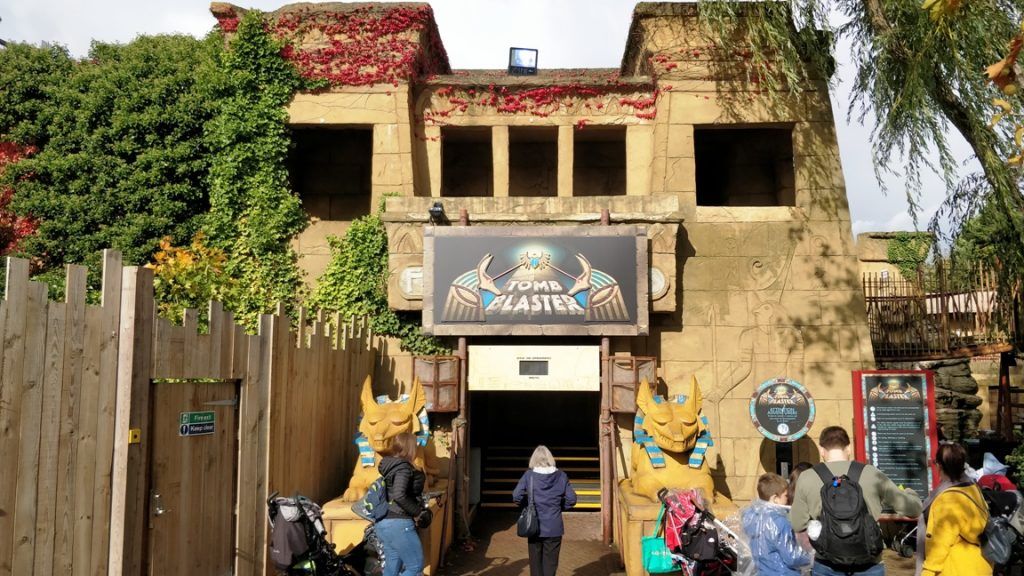
A decade on, Chessington was already in quite a different position to its early 90s growth period, seeing a narrowing target market towards younger families to separate it from Tussauds’ recently acquired, nearby Thorpe Park. Also at this time, interactive shooting rides were being pushed at trade shows around the world, and Tussauds decided to explore this trend as a cost-effective way to revamp existing attractions, starting with Terror Tomb.
Whether it was felt by management that Terror Tomb needed toning down for the younger audience or if it was simply chosen as the test bed for implementing an interactive ride isn’t too certain, but the revamp would turn out to be a significant departure. The ride closed at the end of 2001 to be adapted as Tomb Blaster.
The project was primarily designed by Tussauds’ longtime creative designer John Hilder, who had previously worked on The 5th Dimension, although the concepts were greatly simplified to reach the final results. The new premise worked to strip the theatricality and fantasy atmosphere of the original, now as a tomb under archaeological investigation where a curse had been discovered – and we as guests were participants in a mission to win the highest score. The biggest changes would see the total removal of Abdab (intended to be replaced by various other characters) and a new finale.
The theme would now be explained via video screens in the queue, rather than visually threaded as before. The souk area was reworked as a crate store, with attention moved to the TV screens, and the entry to the passage redressed as a tomb wall recently knocked-through. The passage and station were redressed with scaffold and canvas, as if under archaeological investigation. The sinister ambient music that once occupied this space were replaced by the queue video soundtrack and the regular interruption of a pre-recorded announcement – “It is now safe to remove your blasters”!
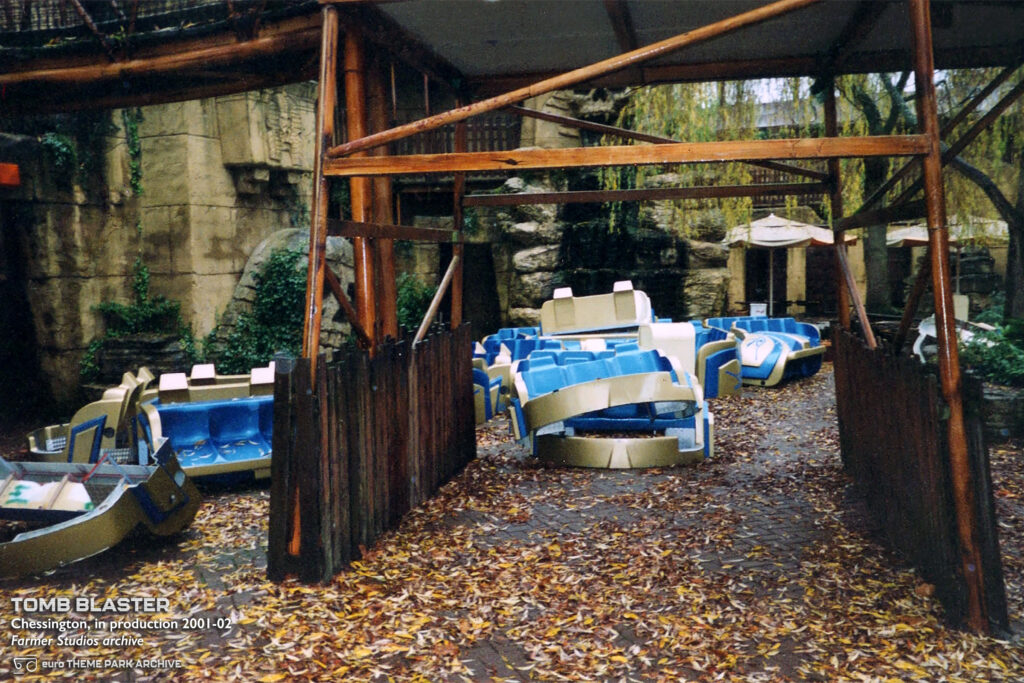
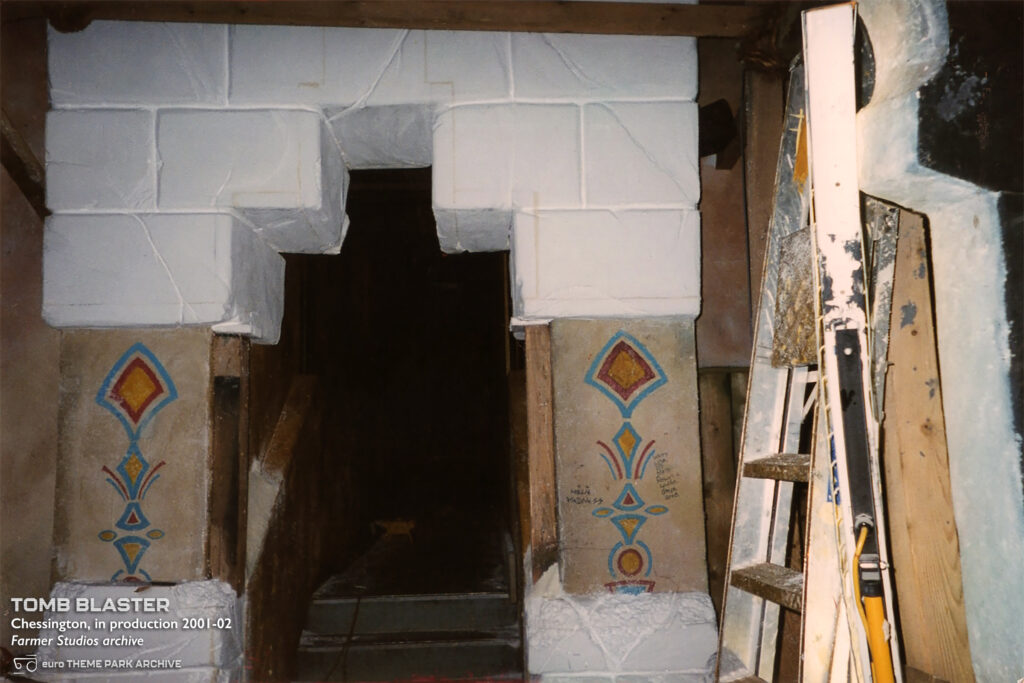
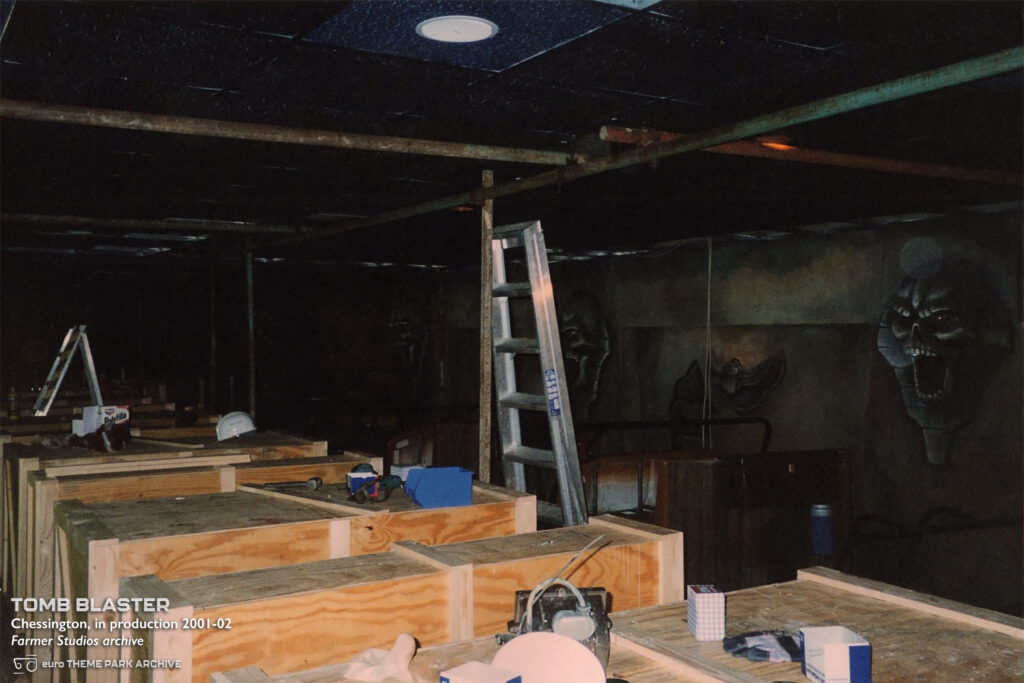
The entire ride was altered to various extents, with most of the original surreal colours painted over block yellow, and several empty spaces where Abdab had stood. Other than the new finale, the only new animation was a mummy replacing Abdab on the Spike room revolving door, but it transpires this was actually the Guitarist figure repurposed with a new head — his hands wiggling a laser gun where they previously strummed the guitar! The shrieking mummies falling towards riders were also toned down, now visible before they moved, to avoid being too scary.
Farmer Studios, by now one of Europe’s leading attraction studios, were again chosen to build the new finale, this time working to Tussauds Studios’ design. The new scene would create an impressive ‘final boss’ for the game. John Hilder’s initial design was for a giant, living cobra statue appearing from behind a tomb door and entering on a track, summoned by an Egyptian god (a redressed Spooky Guitarist). Farmer Studios began to design this animation (pictured below), but the concept was significantly revised.
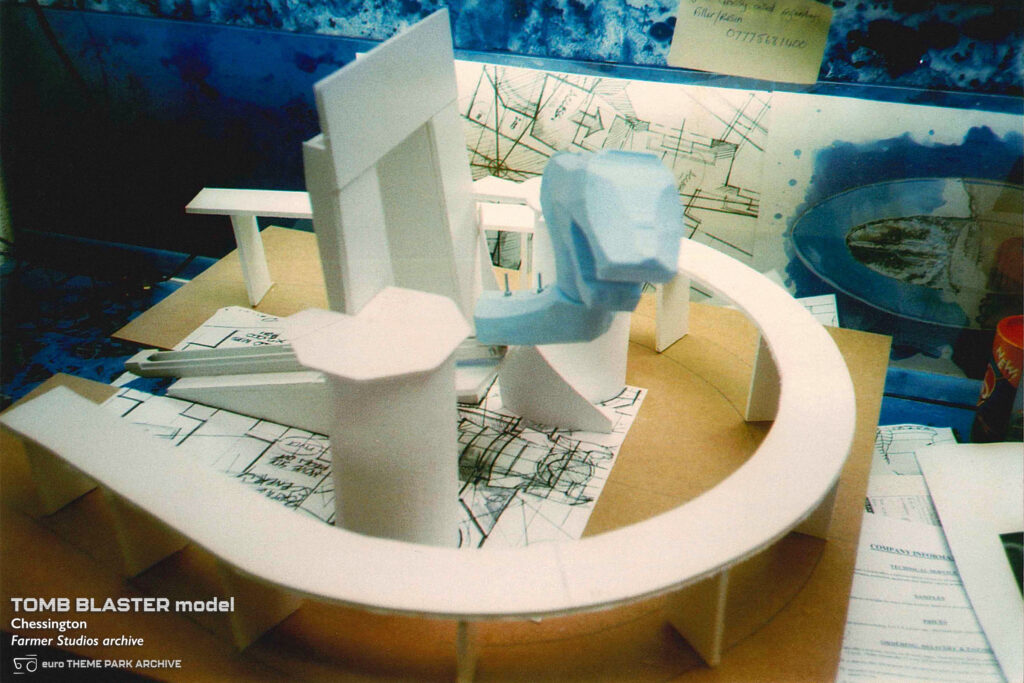
As we know it, the cobra would start the scene already in position and leaning forwards towards riders instead, blowing smoke from its nostrils. The impressive animated figure was engineered by Farmer with an ingeniously simple method that worked to ripple the cobra’s hood in segments (the segmenting obscured by dark lighting), as the cobra’s head turned.
The new cobra made for a memorable finale, backed by a triumphant score. However, the cobra’s smoke and leaning motion was unfortunately disused after some years.
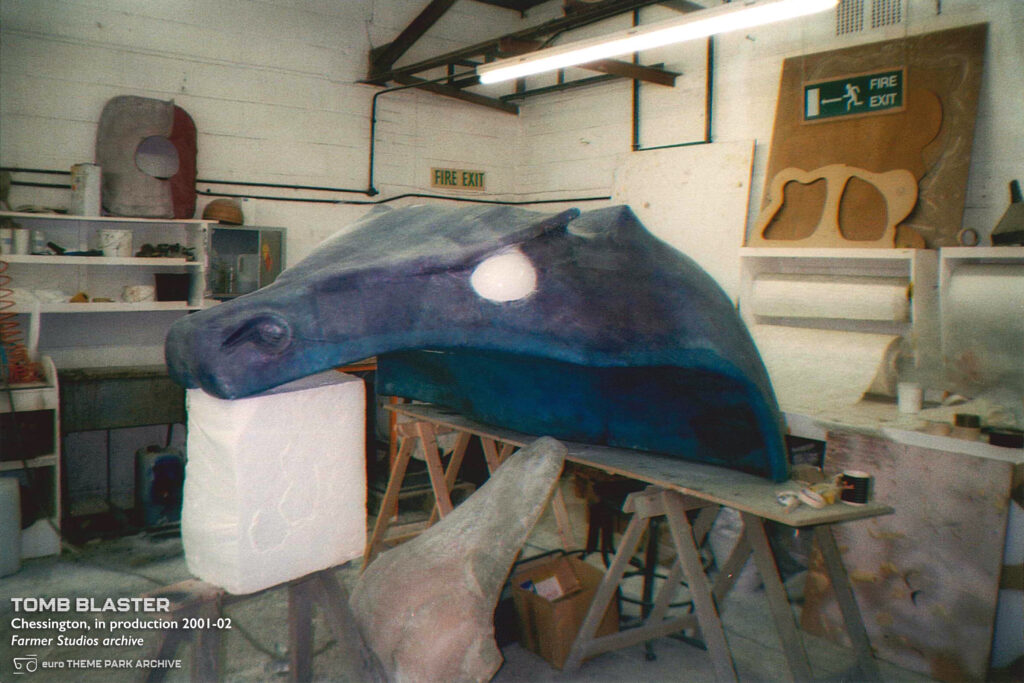
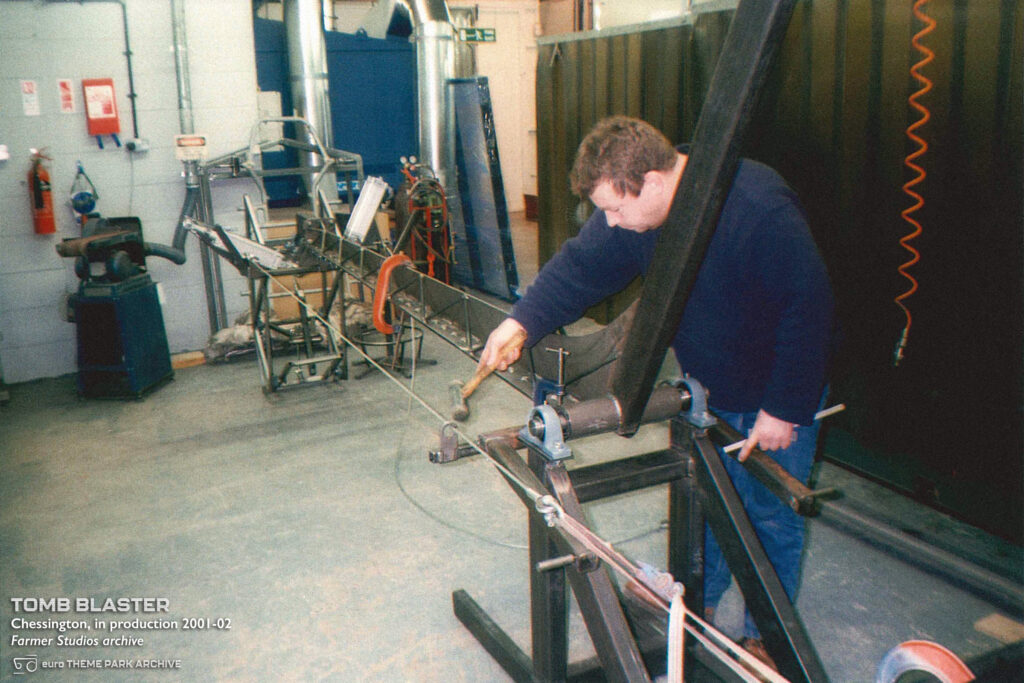
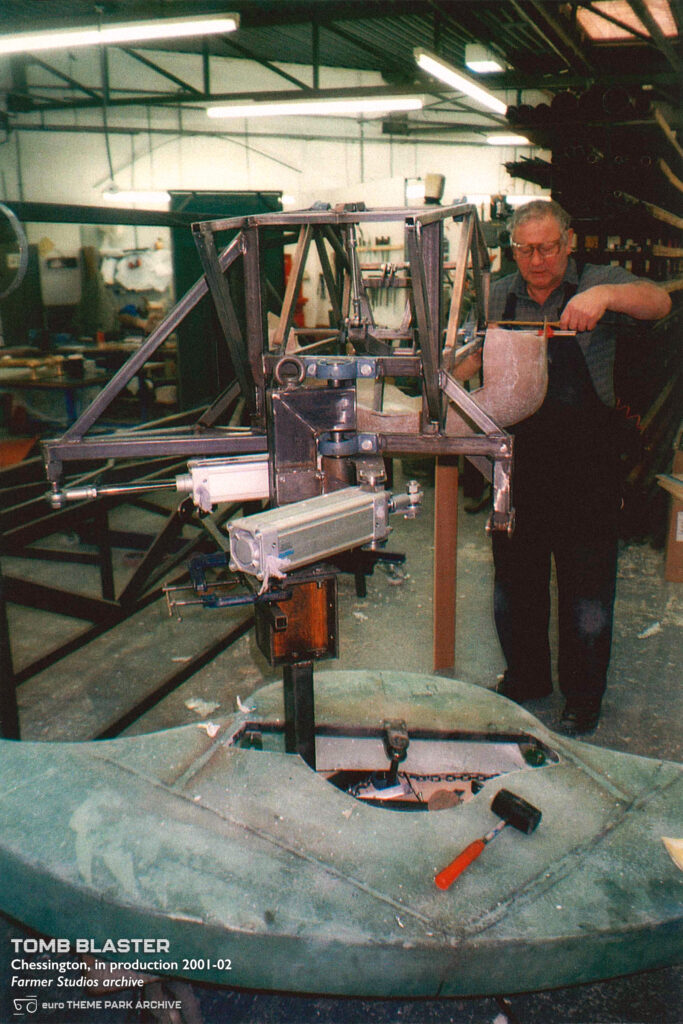

Tomb Blaster introduced a complete new musical soundtrack produced by film and television composer David Buckley, including a very memorable exterior main theme. The remainder of the ride’s AV was a mix of original lighting and audio retained, although oddly the mummies’ cackles were silenced (intended to be replaced by new sounds, which were produced but never installed for an unknown reason). Meanwhile, the original animation systems were retained and partly reprogrammed, with the original PLCs and most their 1994 programming remaining in use to this day.
Some time later, all the disused figures, AV and control equipment were discovered stored away in a hidden room behind the Spike room, where they remained for many years until the room was eventually emptied in 2015.
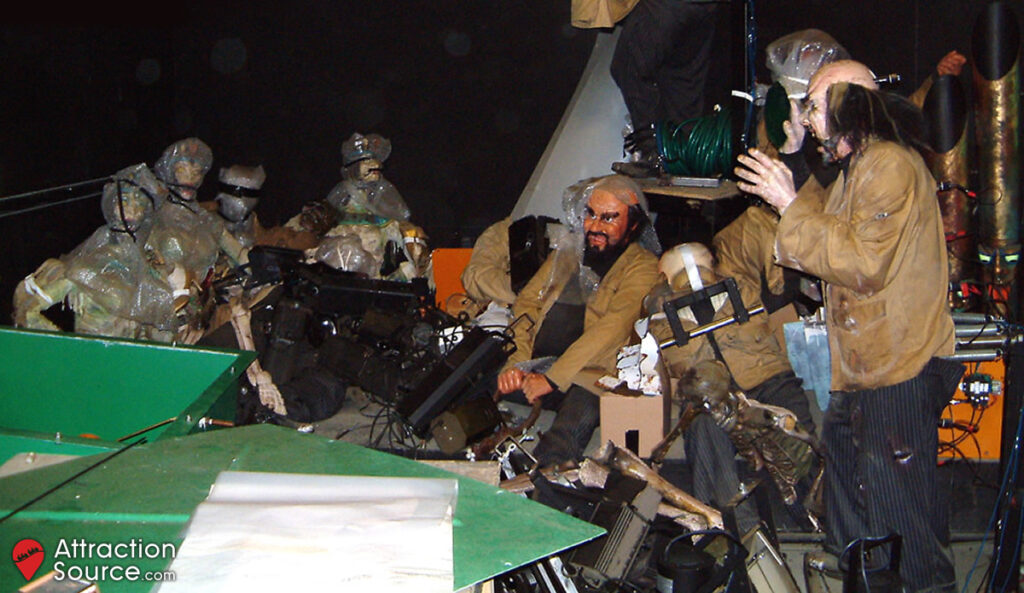
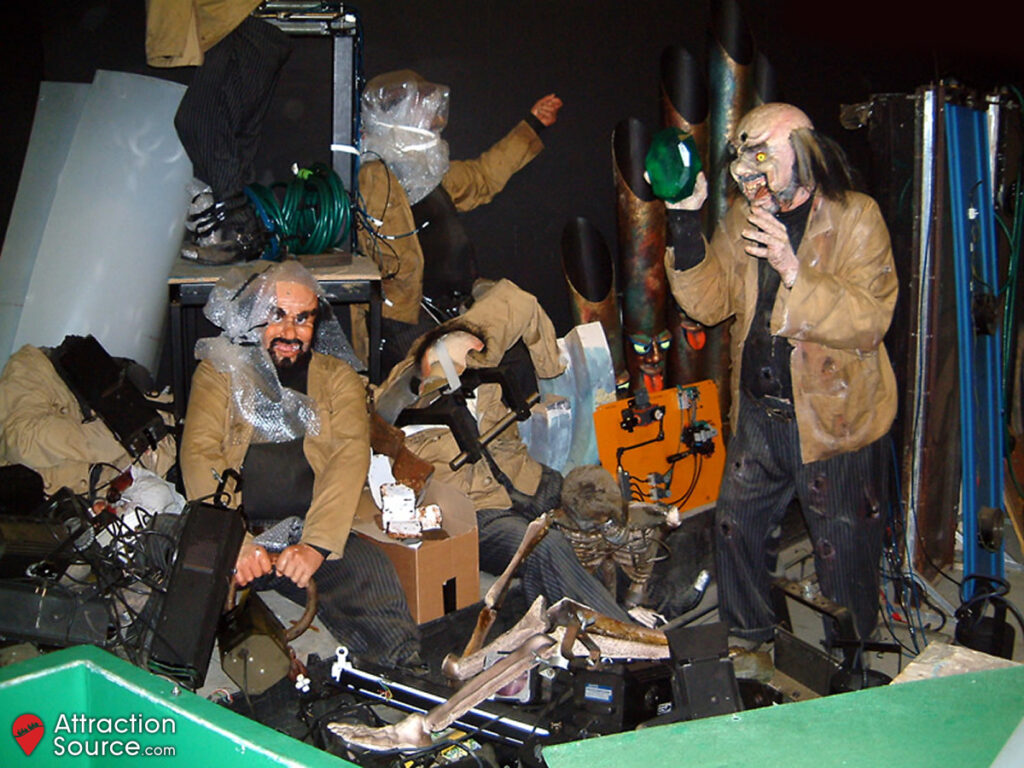
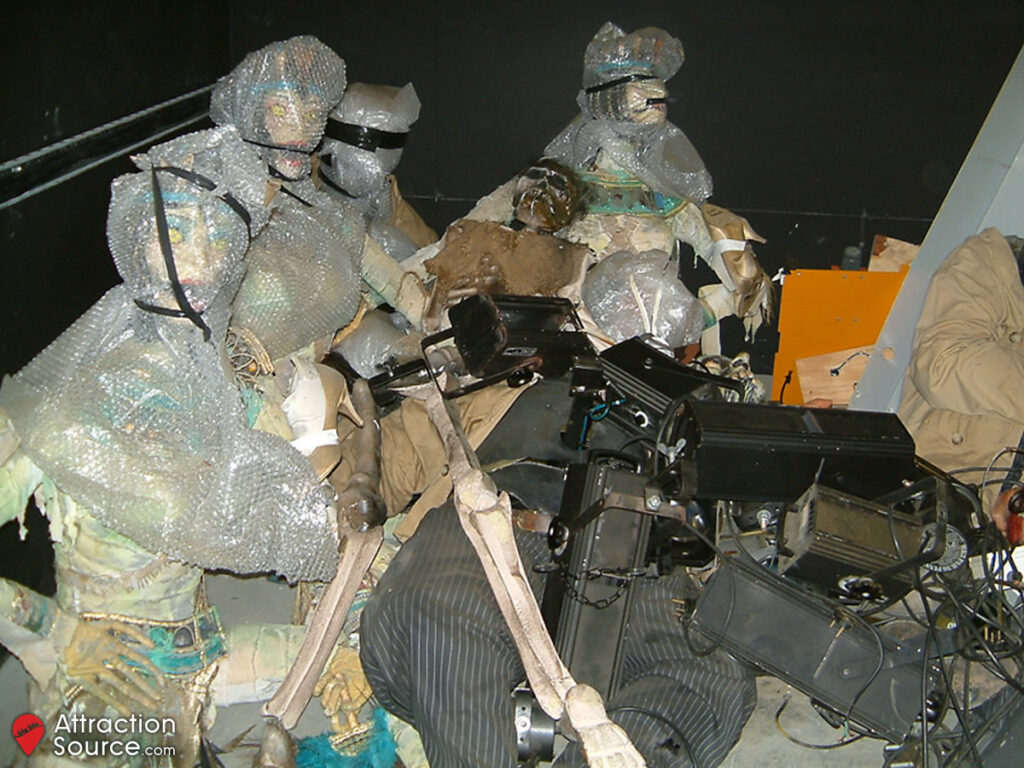
Later Years to Present
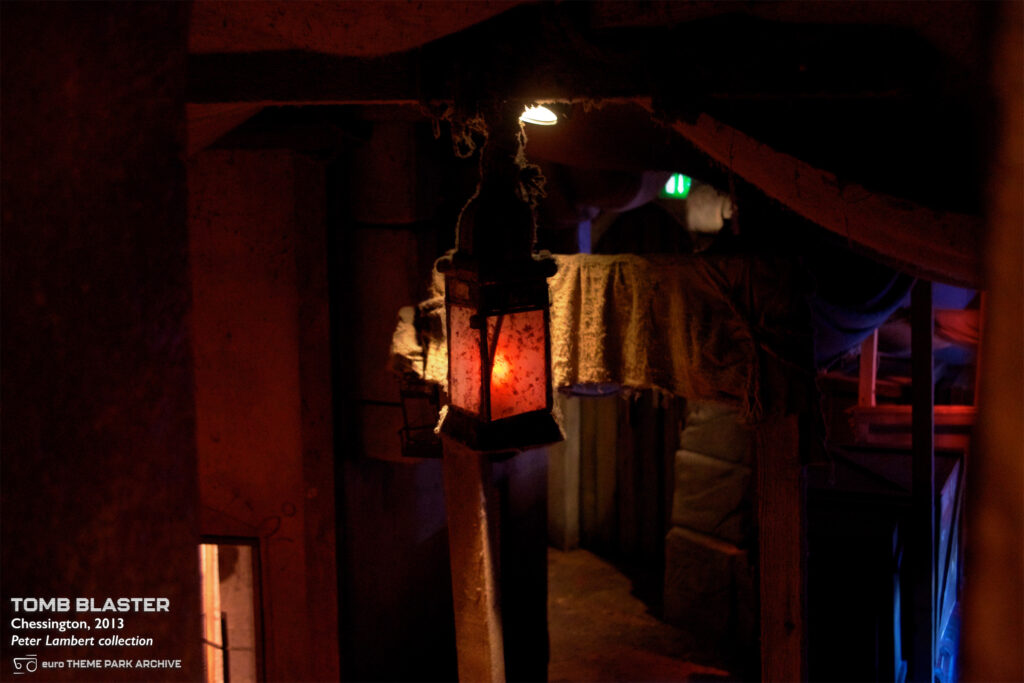
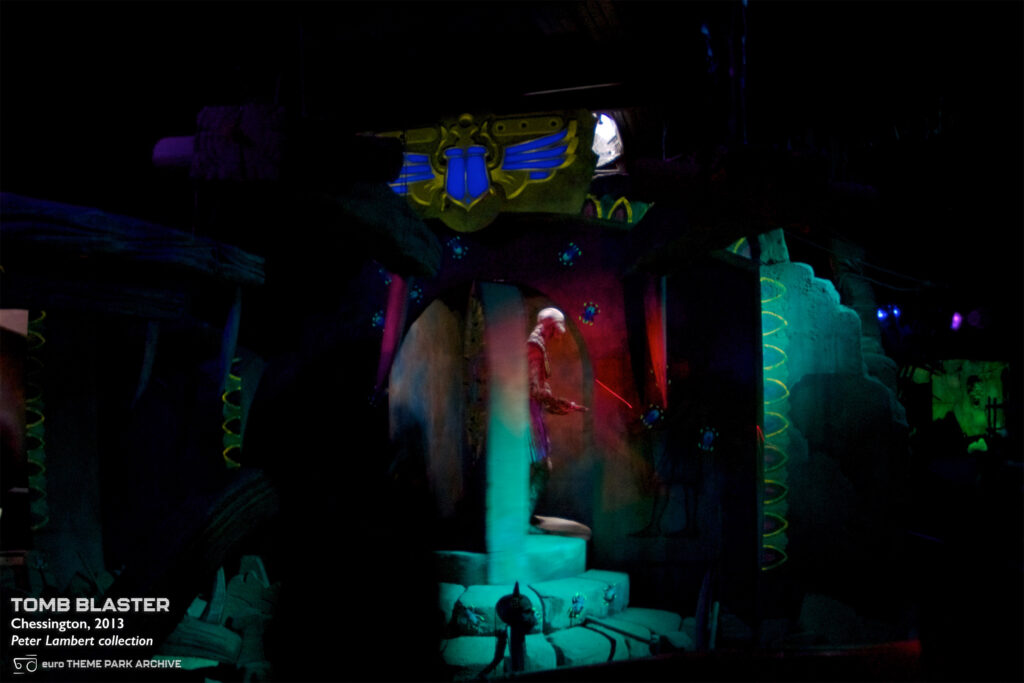
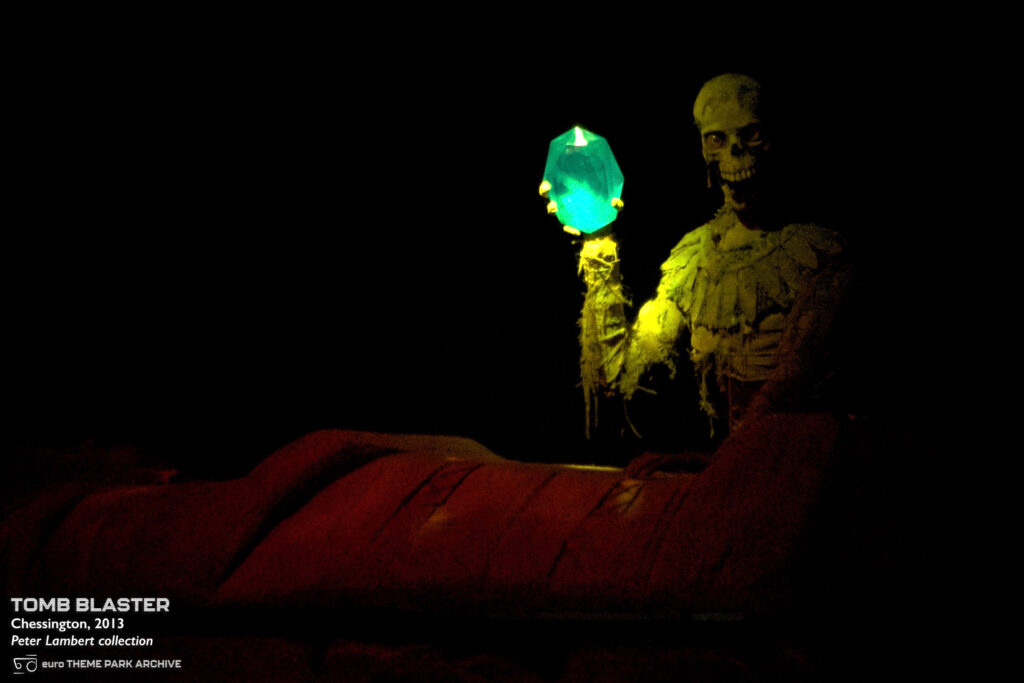

Top middle and top right: the Spike room including a remaining appearance of the ancient emerald from Terror Tomb. Bottom: the giant cobra, on a hot summer day with the roof vents open.
Tomb Blaster, similar to its cousin Duel at Alton Towers, continued for an extended period, until receiving a technical refurbishment in summer 2015. This saw the replacement of the ageing lighting and interactive shooting systems, with a new shooting system built by Dutch manufacturer Lagotronics. The new lighting was decided to be entirely static UV. Unfortunately, this was still during the early days of updating themed lighting to LED technology at UK parks, before the availability of higher quality LED UV that avoided casting visible light, resulting in effects and areas that relied on darkness being exposed. Also as a result of the technical updates, the remaining sound cues synced to various effects were lost.



To address this, another scheme to improve the ride was put together for 2020. Subtitled ‘Defeat The Curse’, this was the 4th iteration since Terror Tomb opened and attempted to reintroduce a theatrical style via new lighting and audio. All-new AV equipment was installed in a short given time, which was largely contracted to Sarner. The new soundtrack was outsourced to composer and theme park enthusiast Nick Hutson, whose voice is in the attraction. The 1994 animation control was retained (without being reprogrammed, as the technology was now obsolete), however the guns now begin switched off until the Snake Pit.
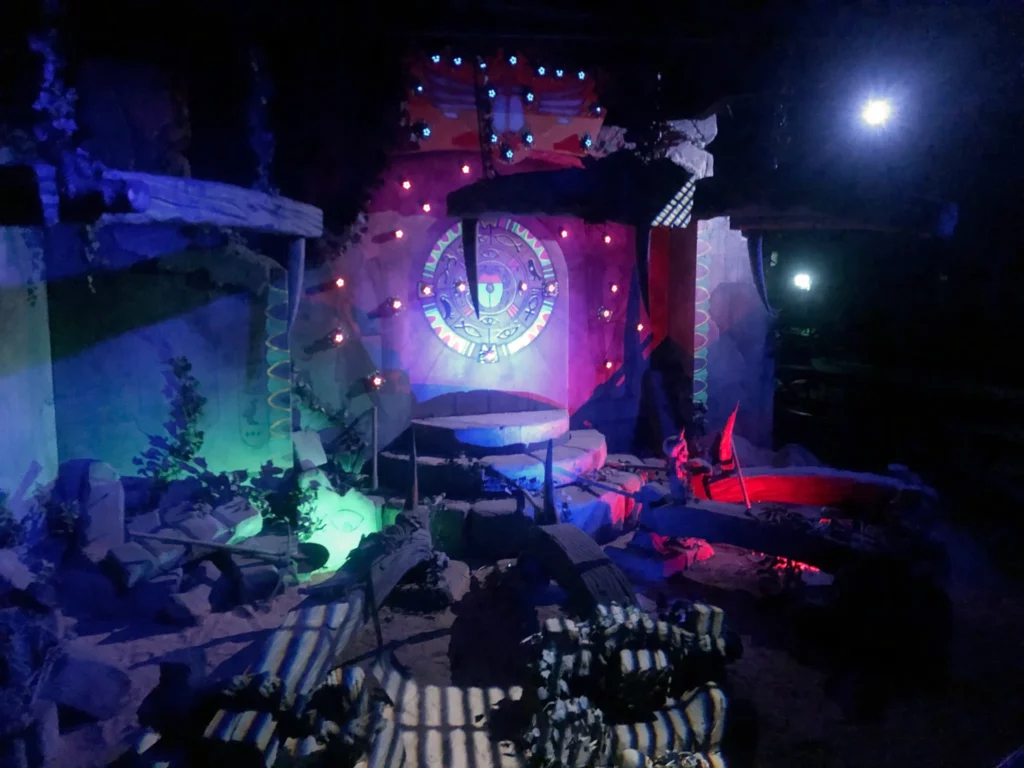
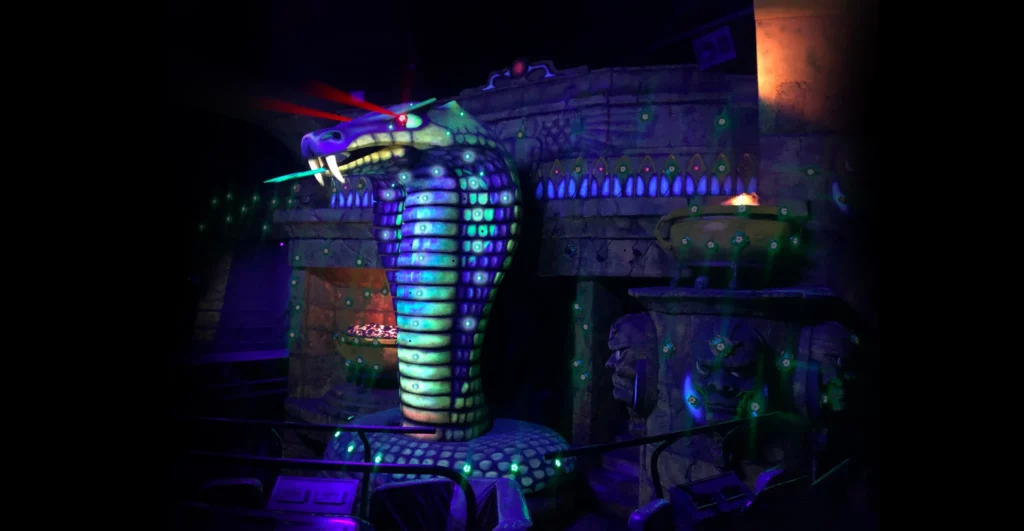
30 years later, the Tomb has entertained multiple generations of visitors to Chessington with its adventurous scale in one form or another. Today, Merlin is in the midst of repositioning its theme parks, in particular revamping many ageing attractions from the early 2000s period. Considering the recent removal of the shooting game from Duel with a new theme as The Curse at Alton Manor, could the future of Tomb Blaster be similar? Or, considering the ride itself is approaching 40, could there be a new development on the horizon?
Whatever the future holds, the original Terror Tomb still holds up as a uniquely entertaining ride, a fantastic achievement in the UK attractions industry and a testament to delivering a dark ride with real dedication and craft.
Written and researched by Peter Lambert.
With special thanks to Nick Farmer, Steven Pearce, all the former Farmer Studios team and Merlin Magic Making for help with research.
Archive pictures © Euro Theme Park Archive unless otherwise stated.

